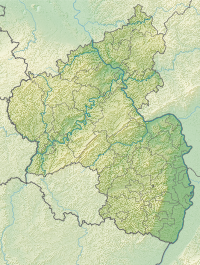Inselrhein
Rheinauen (section of the Upper Rhine) |
Inselrhein or Rheinauen is the name of a section of the Rhine with a number of islands between Mainz and Bingen , from river kilometers 499 (below the Main estuary ) to 527.3 (above the Nahe estuary ). The river islands in this area are called floodplains , from the Petersaue to the Rüdesheimer Aue. The Bleiau and Langenau near Ginsheim are not included as they are above the mouth of the Main. The Maaraue above the Petersaue is also no longer included, as it actually lies in the mouth of the Main. Construction work turned it into a peninsula . The Krausaue below the Rüdesheimer Aue is still in the area of the Rheinaue, but is not considered an island, but a shoal . The Ingelheimer Aue and the Haderaue have also lost their island status due to the straightening of the Rhine , so that the Rheinaue consist of only eight real islands.
Together with the adjacent tail units , still waters and unpaved shoreline with their alluvial forests , they form a chain of nature reserves . Only the Petersaue is not a nature reserve, but a water protection area . This section of the Rhine is the lowest part of the Upper Rhine . 1800 meters below the western tail unit of the Rüdesheimer Aue begins at the Nahe estuary at river kilometer 529.1, above the Binger Loch , the Middle Rhine .
The still waters are used by many water birds such as golden tufts , tufted ducks and goose saws for wintering. They are a year-round habitat for great crested grebes , cormorants , gray herons and gray geese . The wet meadows and sandbanks also offer resting places for numerous waders on their migration. For a few years now there have been white storks again in several places .
The alluvial forest is one of the most species-rich areas in Europe. The softwood meadow near the shore is a regular floodplain and is characterized by willows and poplars . The hardwood floodplain - further inside - has ash , elm and English oak . It is the habitat of numerous birds such as oriole , nightingale and black kite .
Ramsar areas (European reserves)
The following floodplains are European reserves according to the Ramsar Convention on wetlands as habitats for waterbirds and waders:
Mariannenaue
The Mariannenaue is surrounded by tail units that form near-natural still waters. It is the largest geese resting place in the island rhine area. Especially at the western tip, numerous sea ducks can be observed during the bird migration . In Rhineland-Palatinate shoreline there are also long-tailed ducks . With a little luck you can also see the osprey circling in the sky and the threatened middle woodpecker . One sees oriole and graycatcher more often . See also: Mariannenaue
Fulderaue - Ilmenaue
The total size of the protected area is 341 ha. In the still water areas you can find large numbers of golden-headed , eider , tufted and pochard ducks that overwinter here. Cormorants , great crested grebes , little grebes and goosander also hunt fish in the main stream.
Rüdesheimer Aue
In the springtime, numerous cormorants and gray herons breed in the floodplain forests of the Rüdesheimer Aue . The cormorants build their nests in the top of the treetops , while those of the gray herons lie on the lower levels.
Nature reserves
Wiesbadener Rettbergsaue and Mombacher Rheinufer
In addition to gray herons and the ring-necked parakeets that have been introduced over the past few years, several black kites breed in the Rettbergsaue area and the banks of the Mombach Rhine . The tall trees of the island offer up to 200 specimens of these birds to roost during the autumn migration.
Königsklinger Aue - Haderaue
The total size of the protected area around the Königsklinger Aue near Eltville is 165 hectares. The area was proposed as a protected area according to the Fauna-Flora-Habitat Directive (FFH area) of the European Commission because of its extensive softwood forests .
Old pool of sand
The 3 km long arm of the Old Rhine is a stagnant body of water except when it is flooded. Typical birds of the riparian forest can be seen here: oriole, nightingale , small , medium and great spotted woodpecker .
Winkeler Aue
The Winkeler Aue , only 6 hectares in size, is an important resting place for numerous migrants and winter guests. Almost all water birds and waders that rest in the European reserve can be observed here. In addition to nightingales and yellow mockers , it is home to the main breeding colony of various native geese , including gray geese .
See also
literature
- Christian Kühne , Norbert Bartsch and Ernst Röhrig (forest scientist) | Ernst Röhrig: Silvicultural treatment of the floodplain forests on the Upper Rhine with special consideration of the English oak (Quercus robur L.) . Writings from the Forestry Faculty of the University of Göttingen and the Northwest German Forest Research Institute (Volume 140). Verlag Sauerländer , Frankfurt am Main 2005, 137 pages, ISBN 3-7939-5140-5
Web links
- NABU nature conservation center Rheinauen
- Outside service
- Bird observation area Inselrhein HGON - Hessian Society for Ornithology and Nature Conservation eV
- Natura 2000 Hessen: Standard data sheet extract Inselrhein
- Reiner Letzner: Rheinauen between Mainz and Bingen





